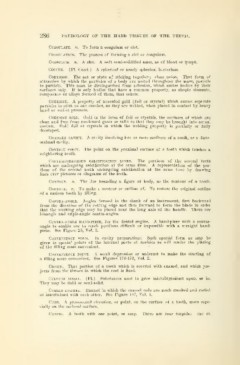Page 544 - My FlipBook
P. 544
286 PATHOLOGY OF THE HABD TISSUES OF THE TEETH.
Coagulate, v. To form a coagulum or clot.
Coagulation. The process of formiiig a clot or coagulum.
Coagulum. n. A clot. A soft semi-solidified mass, as of blood or lymph.
Coccus. (PI. Cocci.) A spherical or nearly spherical bacterium.
Cohesion. The act or state of sticking together; close union. That form of
attraction by which the particles of a body are united throughout the mass, particle
to particle. This must be distinguished from adhesion, which unites bodies by their
surfaces only. It is only bodies that have a common property, as simple elements,
compounds or alloys formed of them, that cohere.
Cohesive. A property of annealed gold (foU or crystal) which causes separate
particles to stick to one another, as they are welded, when placed in contact by heavy
hand or mallet pressure.
Cohesive gold. Gold in the form of foil or crystals, the surfaces of which are
clean and free from condensed gases or salts so that they may be brought into actual
contact. Gold foil or crystals in which the welding property is partially or fully
developed.
Complex cavity. A cavity involving two or more surfaces of a tooth, as a disto-
oeclusal cavity.
Contact point. The point on the proximal surface of a tooth which touches a
neighboring tooth.
Contemporaneous calcification lines. The portions of the several teeth
which are undergoing calcification at the same time. A representation of the por-
tions of the several teeth undergoing calcification at the same time by drawing
lines over pictures or diagrams of the teeth.
Contour, n. The line bounding a figure or body, as the contour of a tooth.
Contour, v. To make a contour or outline of. To restore the original outline
of a carious tooth by filling.
Contra-angle. Angles formed in the shank of an instrument, first backward
from the direction of the cutting edge and then forward to form the blade in order
that the working edge may be placed near the long axis of the handle. There are
binangle and triple-angle contra-angles.
Contea-angle hand-piece, for the dental engine. A hand-piece with a contra-
angle to enable one to reach positions diflBcult or impossible with a straight hand-
piece. See Figure 25, Vol. 2.
Convenience form. In cavity preparation: Such special form as may be
given to special points of the internal parts of cavities as will render the placing
of the filling more convenient.
Convenience point. A small depression or undercut to make the starting of
a filling more convenient. See Figures 170-173, Vol. 2.
Crown. That portion of a tooth which is covered with enamel, and which pro-
jects from the tissues in which the root is fixed.
Culture media. (PI.) Substances used to grow microorganisms upon, or in.
They may be fluid or semi-solid.
Curled enamel. Enamel in which the enamel rods are much crooked and curled
or intertwined with each other. See Figure 147, Vol. 1.
Cusp. A pronounced elevation, or point, on the surface of a tooth, more espe-
cially on the occlusal surface.
Cuspid. A tooth with one point, or cusp. There are four cuspids: one on


